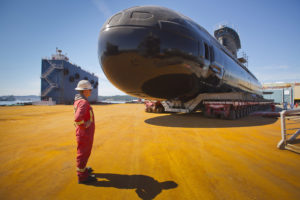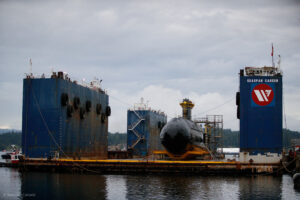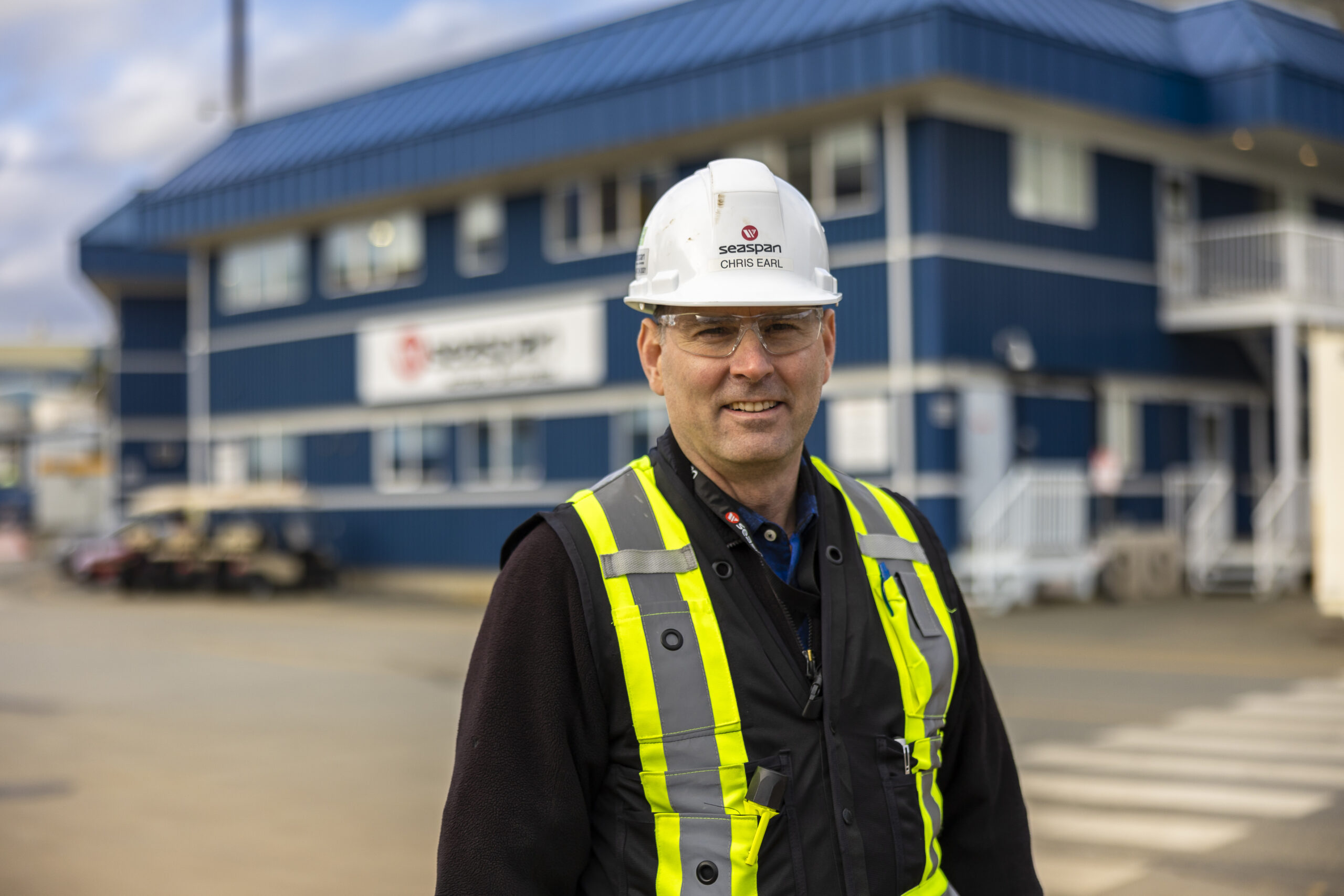March 16, 2023
Chris Earl is a retired Rear Admiral with the Royal Canadian Navy and brings 35 years of submarine experience to Seaspan Victoria Shipyards, where he is currently the Vice President of Project Delivery. We sat down with Chris to learn more about the history and future of Canada’s submarine program and how Victoria Shipyards is uniquely positioned to support it.
Q: You spent 35 years in the Navy prior to joining us at Seaspan – how did that experience shape your role here at Victoria Shipyards?
Beginning very early in my Naval career I was responsible for people and programs. Early on, I served as an operational submarine engineer in four different platforms both here and in the United Kingdom. That, and four years in the Royal Navy submarine support organization, prepared me to run Canada’s Submarine Program and following that I had the opportunity to manage and lead Canada’s Naval Maintenance Facility in Esquimalt; effectively the Navy’s version of Victoria Shipyards. After four years in that role, I became the Royal Canadian Navy’s Chief Engineer, which has responsibility for managing all programs for the Royal Canadian Navy, overseeing all technical occupations and is responsible to the Commander of the Navy for technical readiness. My roles over the last 10 years in uniform are very similar to my role today: communicating with people, connecting with stakeholders, networking within the industry, breaking down barriers and supporting a team to deliver to an agreed schedule. There are subtle differences but my current Victoria Shipyards role feels reminiscent of my time running the Navy’s Fleet Maintenance Facility. It’s an environment that I love.
Speaking of love, what do you love about Seaspan and Victoria Shipyards specifically?
One of the great things about being the Chief Engineer of the Navy, is that I had a responsibility to build relationships with all the major shipyards in Canada — and in running the In-Service Program, I dealt regularly with Seaspan’s Victoria Shipyards and Irving out in Halifax. I also spent eight years in the UK running submarines, and I had the opportunity to see differences in how shipyards are run – I also got a sense of the people and culture at various yards. I was always super impressed by the commitment and culture of Seaspan Shipyards and the people here in Victoria are amazing. I’m biased now but Victoria has always been my favorite when it came to ship maintenance – and when I had a choice after my career with the Navy, it was an easy one to make.
You are known across Seaspan as the ‘Submarine guy’ – how does one gain that moniker?
30 years either in operational submarines or directly supporting them is probably a good place to start. My career in submarines started in the early 1990s in the Oberon Class boats; 3 submarines built in the United Kingdom in the 1960s and used by Canada until the late 1990s. In April 1998 Canada decided to buy the Upholder Class submarines from the United Kingdom; four submarines that were built in a couple different shipyards in the UK in the late 1980s and early 1990s.
That decision changed my life as over the next 15 years I would be involved in pretty much every facet of that program and the operation and maintenance of that Class. Canada renamed the class the Victoria Class and I ended up bringing HMCS CORNER BROOK to Canada only to return to the UK for another four years of supporting and operating submarines for the Royal Navy. The intent of that was to understand how to run a program and I returned to Canada in 2008 to do just that. The rest is history, but I have spent my whole career working in or around submarines.

Can you walk us through Victoria Shipyard’s submarine program?
Seaspan originally got involved in Victoria Class maintenance in 2005 when the Fleet Maintenance Facility (FMF) in Esquimalt did their first Extended Docking Work Period on HMCS VICTORIA. The FMF needed some help and Victoria Shipyards stepped up to support.
In 2007, the Victoria In-Service Support Contract was awarded to the Canadian Submarine Maintenance Group (CSMG) and Seaspan was a part of that delivery model – CSMG later became Babcock Canada and that’s how everything evolved to where it is today. The delivery of deep submarine maintenance in Canada is effectively provided by three partners known as Team Victoria Class, which includes Babcock Canada, BMT, and Victoria Shipyards. Babcock is the prime and is responsible for engineering, integrated logistics, liaising with Canada, and managing the schedule and refit program. BMT provides engineering support and oversees materiel certification activities, while Victoria Shipyards provides the production workforce and manages all the infrastructure needed to support the refits at the Esquimalt Graving Dock (EGD).
Infrastructure here at EGD consists of a Purpose-Built Repair Facility (PBRF), essentially a barn that you pull a submarine into, and a submarine compound which contains shops, offices and specialty support equipment in a sensitive gated off area. Submarines are transferred into the PBRF using hydraulic transporters and docked/undocked using Vancouver Drydock’s Careen.
Do you have any exciting milestones coming up at Victoria Shipyards?
We recently had an exciting milestone for our submarine program – initial work to prepare for HMCS Victoria’s Extended Docking Work Period has begun – that work has now kicked off and the team here at Victoria Shipyards has started removing all the equipment off the submarine, allowing the surveys to be done to ensure the submarine will be safe to operate for the next 12 years. It’s an exciting phase because you get in there and can see lots of different things that you wouldn’t normally see.

We’re also very close to delivering HMCS CORNER BROOK back to the Navy. Just before Christmas, that submarine was transferred back to the naval yard for final commissioning and trials.
This work is highly specialized and niche — How many people do you have on your team and how do you retain talent?
We have a core program team of 50-60 people and many of them have been involved in submarine work since day one – going on 15 years. In addition, the team consists of a production workforce of 250-300 highly skilled tradespeople all of whom are exceptionally dedicated. They work in tight spaces, contort their bodies to get at systems/equipment and sometimes even weld with mirrors. Their knowledge and skills have been built over time and represent a huge investment by the Government of Canada. Having a workforce that understands the submarine culture, understands the material certification requirements, and understands and delivers the quality necessary, takes a lot of time and investment and I’m very proud to be part of that team. There are many strategies to retain this talent but essentially it comes down to providing them continuous and challenging work and ensuring that Seaspan provides them the best working environment possible.
Q: Where do we go from here? What are the next steps for Team Victoria-Class and submarines in Canada?
I think the first thing to say is that we are 100 percent committed to delivering the VICTORIA Extended Docking Work Period program. That deep maintenance period needs to be delivered much more succinctly than we traditionally have done in the past. The Government of Canada has targeted 4 years but there needs to be significant improvements to achieve that. Realistically if Team Victoria-Class can deliver the submarine back to Canada with all the capabilities they need in five years, that will be a huge win as Canada needs operational submarines to counter the security challenges that exist in the world right now.
Beyond HMCS VICTORIA, the team here at Victoria Shipyards needs to continue to improve how we provide support to the Victoria Class so that we can be in this business until its end of service and prepare for the transition to whatever class of submarine comes next. Transitions are difficult as it always takes more people to support the outgoing and incoming platform than it normally does during a steady state. The submarine qualified and experienced workforce that I spoke of earlier will be in short supply and thus, we need to grow this capability over the coming years to ensure that the capacity exists in Canada to maintain the next generation of submarines for Canada when the time comes.
